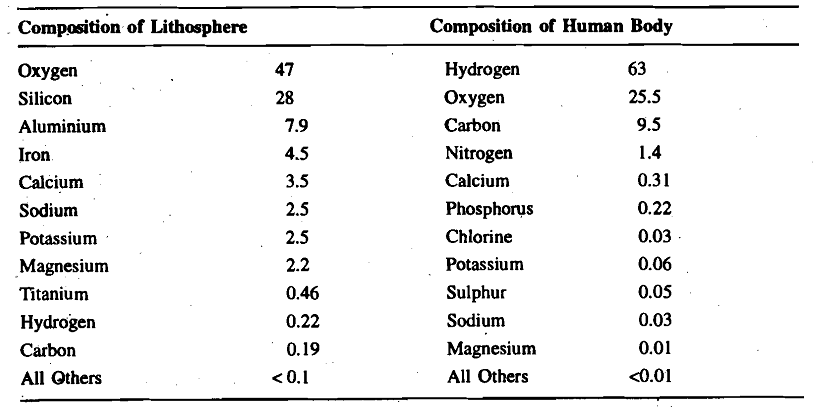Chemistry of Living Matter
All living things including ourselves, are made of protoplasm. Protoplasm is essentiallya colloidal suspension of proteins in a w&ery solution. It is composed of molecules, the main element being carbon, which occurs in association with hydrogen, nitrogen and oxygen. Other elements like phosphorus, calcium, sodium etc. occur in small quantities. Table.
Table: Composition of elements in the earth's crust (the lithosphere) and the human body. Each number represents the percent of the total number of atoms present; for example 47 of every 100 atoms found in a representative sample of the earth's crust are oxygen atoms. Whereas there are only 19 atoms of carbon in every 10,000 atoms of the earth's crust. The four most abundant elements in the earth's crust are oxygen, silicon, aluminium and iron. While the four most abundant elements in Living organism are hydrogen, oxygen, carbon and nitrogen. So except for oxygen, in living organism, ,silicon, aluminium and iron occur only in traces. About 75% of the body of most animals is composed of water and 50% of the remaining dry weight is carbon with little if any silicon. The earth's crust in contrast, consists of 28% silicon and less than 0.1% carbon.

This table compares the relative abundance of the most prevalent elements in the earth's crust with those in our body. As you can see from the table, living matter makes use of only very few of the elements available to it. Furthermore, the relative proportion of elements found in living organisms is different from that found in the environment. In other words, living matter can take up certain elements that are scarce in the nonliving environment and concentrate them within living cells.
Moreover, there is a rapid turnover of material in living things. For example, carbon is taken up in the form of sugar, and is given out in the form of carbon dioxide. You do not see the same carbon atom in an organism bemanently. Thus the organisation of atoms and molecules in living systems is more dynamic than in nonliving objects, such as rock. The rock we see today contains the same atoms it had last year. By contrast the rabbit we see today is largely composed of atoms acquired since we saw it last year.The carbon based compounds produced by living organisms can be divided broadly into carbohydrates, fats and proteins. These then get organized into structures - called cells which form the basic units involved in the specific organization of organisms.